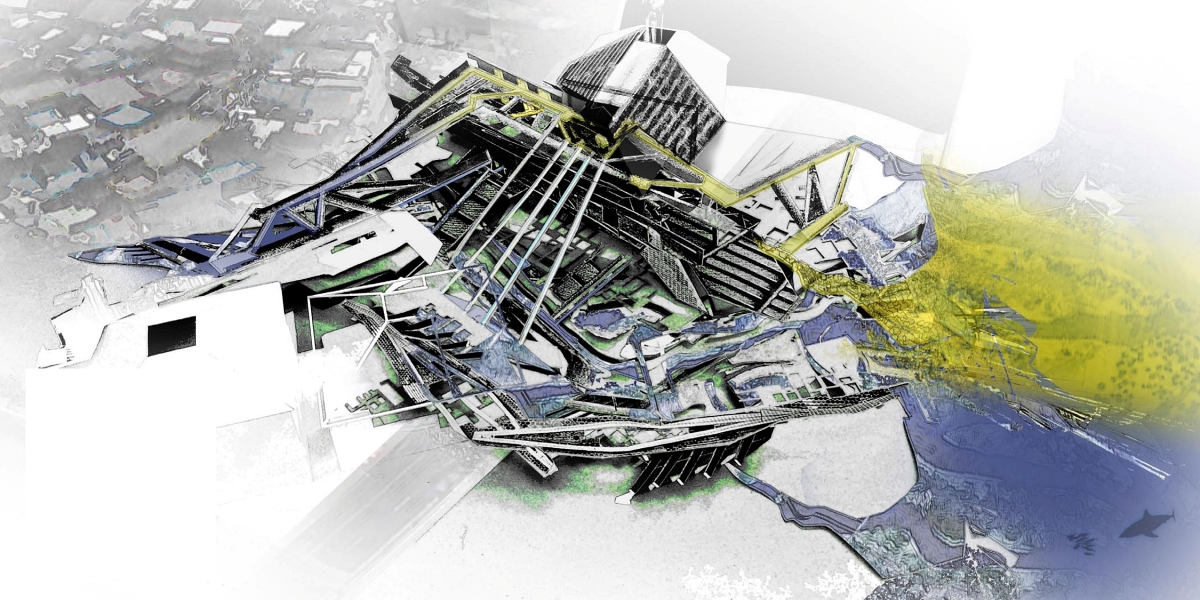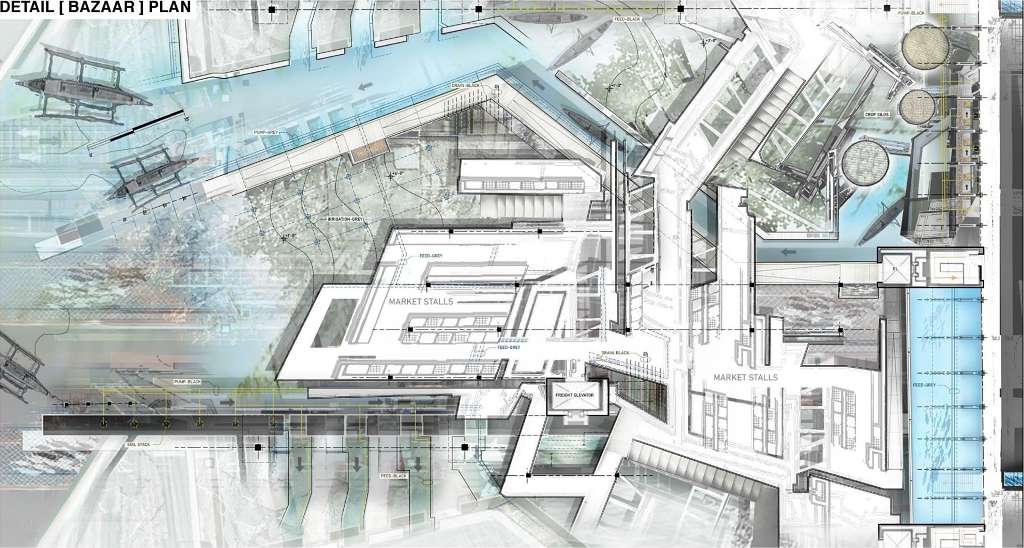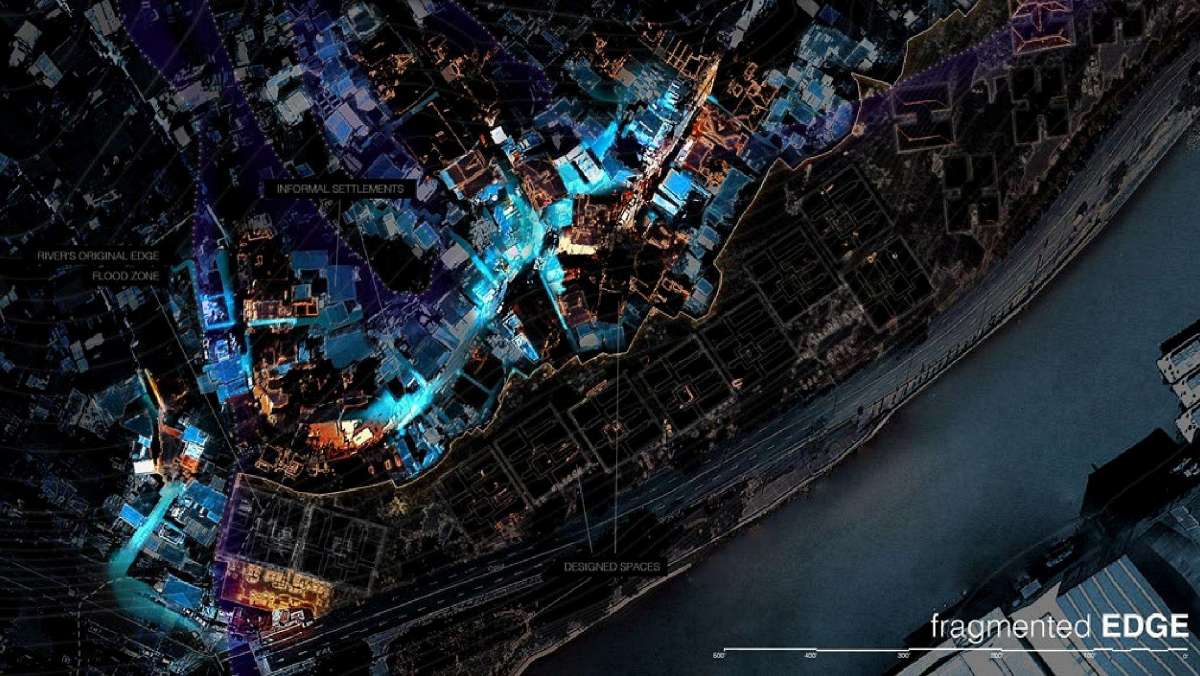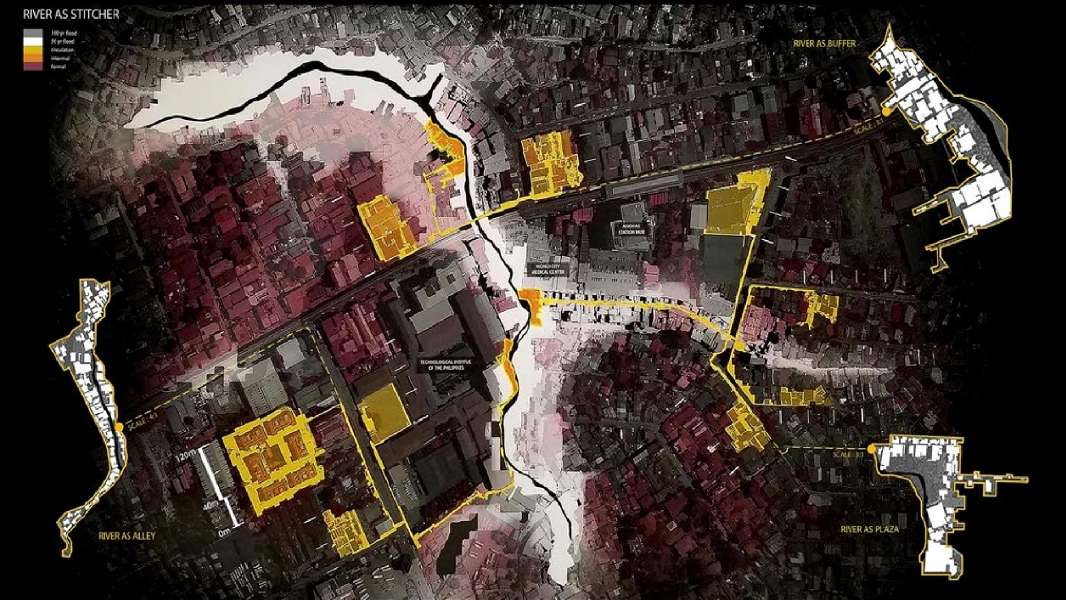a STITCHING [ BAZAAR ]
STUDIO
Designing for Exigency: Metro-Manila Spring 2020
Michael Su + Phillipe Baumann + David Kim
(DPAC) Ane Gonzalez Lara + Rychiee Espinosa
COMPETITION
This competition calls for a STITCHING [ BAZAAR ]
to stitch the informal settlements with the Pasig River.
The bazaar will be located at the south riverbank of Cembo Barangay,
Makati City, where it will catalyze new dialogs between
informal settlements and the the city.
STITCHING [ BAZAAR ]
A new typology that conflates architectures and infrastructures of
LIVE WORK LAND WATER. Think of these as one thing.
CONSIDERATIONS
This project considers three questions in the context of
tackling Manila’s ongoing neglect and inequality.
1. Why is infrastructure usually distinct from architecture?
2. Why is water rarely designed as part of the city? (as Burnham did for Manila)
3. What if architecture can reconnect a city with its long-lost waterways?
Designing for Exigency: Metro-Manila Spring 2020
Michael Su + Phillipe Baumann + David Kim
(DPAC) Ane Gonzalez Lara + Rychiee Espinosa
COMPETITION
This competition calls for a STITCHING [ BAZAAR ]
to stitch the informal settlements with the Pasig River.
The bazaar will be located at the south riverbank of Cembo Barangay,
Makati City, where it will catalyze new dialogs between
informal settlements and the the city.
STITCHING [ BAZAAR ]
A new typology that conflates architectures and infrastructures of
LIVE WORK LAND WATER. Think of these as one thing.
CONSIDERATIONS
This project considers three questions in the context of
tackling Manila’s ongoing neglect and inequality.
1. Why is infrastructure usually distinct from architecture?
2. Why is water rarely designed as part of the city? (as Burnham did for Manila)
3. What if architecture can reconnect a city with its long-lost waterways?
Artist Statement
CONTEXT
Today, Manila is notorious for the encompassing scale and diverse variation of its architecture, which range from vast, informal settlements along the city’s margins, to gleaming, steel-and-glass towers in massive, gated communities like Rockwell and Bonifacio Global City. The continuing inequality and neglect must be seen to be believed. Informal communities like BASECO are actually planned to be left intact in order to provide ready labor for the adjacent City of Pearl, a literal island of wealth and privilege.
EFFECT
The STITCHING [ BAZAAR ] creates a new waterfront that faces the city to its waterways and doing so will force the city to clean them up and utilize them once again for future generations.
DESIGN
The Stitching [Bazaar] is defined by two large Stitches that dissolve the existing edges. One Stitch anchors water-cleaning infrastructure and housing to the site; mechanically pumping water up the topography. The other Stitch becomes a new live river as the water naturally flows back down. These two stitches interlace to become the [Bazaar] that hosts programmatic elements related to live, work, land, and water.
The two large scale stitches ultimately function as a way to make the Pasig useful again. The Pasig is in a state that cannot sustain life. Through water filtration, the water can again sustain life like fish and be used to irrigate crops. The new live river that is created by this filtration becomes productive and allows for programs of live, work, land, and water to stitch together.
CLIMATE CRISIS RESPONSE
We propose a novel urban hybrid of architecture and infrastructure to combat
the climate crisis in Manila.
The 25km long Pasig River in Manila once served as the city’s bustling, main
thoroughfare, as it connected far inland communities to the abundance of
Manila Bay. Its ample shores sheltered countless fishing villages, and even
inspired Daniel Burnham to consider Manila as the “Venice of the East†in his
1905 redevelopment plan for America’s latest colonial acquisition. A century
later, its flow has become choked with garbage, its waters contaminated with
chemical runoff and sewage, and its shores congested by the precarious
scaffolding of informal communities. Unsurprisingly, the Pasig River was
declared functionally dead in 2009. The climate crisis has not only compounded
these exigent issues, but transformed their effects.
In response, our hybrid incrementally FILTERS the water of the Pasig River
along its entire length, gradually FLOATS the core services of immediate areas
to provide both short term shelter and long term resilience, and directly
CONNECTS adjacent communities to re-establish long-lost circulations.
Further, our project accommodates the myriad, complex requirements of the
remaining, lingering fishing communities in order to bolster their hold along the
shores. Specifically, the spaces of our project are not defined by walls, but by
architectural stitches between Live, Work, Land, and Water.
akhan6@pratt.edu + 1 201 647 4565
jleaming@pratt.edu + 1 413 668 5528
Today, Manila is notorious for the encompassing scale and diverse variation of its architecture, which range from vast, informal settlements along the city’s margins, to gleaming, steel-and-glass towers in massive, gated communities like Rockwell and Bonifacio Global City. The continuing inequality and neglect must be seen to be believed. Informal communities like BASECO are actually planned to be left intact in order to provide ready labor for the adjacent City of Pearl, a literal island of wealth and privilege.
EFFECT
The STITCHING [ BAZAAR ] creates a new waterfront that faces the city to its waterways and doing so will force the city to clean them up and utilize them once again for future generations.
DESIGN
The Stitching [Bazaar] is defined by two large Stitches that dissolve the existing edges. One Stitch anchors water-cleaning infrastructure and housing to the site; mechanically pumping water up the topography. The other Stitch becomes a new live river as the water naturally flows back down. These two stitches interlace to become the [Bazaar] that hosts programmatic elements related to live, work, land, and water.
The two large scale stitches ultimately function as a way to make the Pasig useful again. The Pasig is in a state that cannot sustain life. Through water filtration, the water can again sustain life like fish and be used to irrigate crops. The new live river that is created by this filtration becomes productive and allows for programs of live, work, land, and water to stitch together.
CLIMATE CRISIS RESPONSE
We propose a novel urban hybrid of architecture and infrastructure to combat
the climate crisis in Manila.
The 25km long Pasig River in Manila once served as the city’s bustling, main
thoroughfare, as it connected far inland communities to the abundance of
Manila Bay. Its ample shores sheltered countless fishing villages, and even
inspired Daniel Burnham to consider Manila as the “Venice of the East†in his
1905 redevelopment plan for America’s latest colonial acquisition. A century
later, its flow has become choked with garbage, its waters contaminated with
chemical runoff and sewage, and its shores congested by the precarious
scaffolding of informal communities. Unsurprisingly, the Pasig River was
declared functionally dead in 2009. The climate crisis has not only compounded
these exigent issues, but transformed their effects.
In response, our hybrid incrementally FILTERS the water of the Pasig River
along its entire length, gradually FLOATS the core services of immediate areas
to provide both short term shelter and long term resilience, and directly
CONNECTS adjacent communities to re-establish long-lost circulations.
Further, our project accommodates the myriad, complex requirements of the
remaining, lingering fishing communities in order to bolster their hold along the
shores. Specifically, the spaces of our project are not defined by walls, but by
architectural stitches between Live, Work, Land, and Water.
akhan6@pratt.edu + 1 201 647 4565
jleaming@pratt.edu + 1 413 668 5528
Quick Overview
2 minute video of presentation - https://youtu.be/To05xX56q14
Presentation Slides
Keynote Slideshow - https://www.icloud.com/keynote/0rTOeJTquBekSEzei6S9l1pyQ#Joe__Azeem_Presentation
Project Booklet
Research and Design








